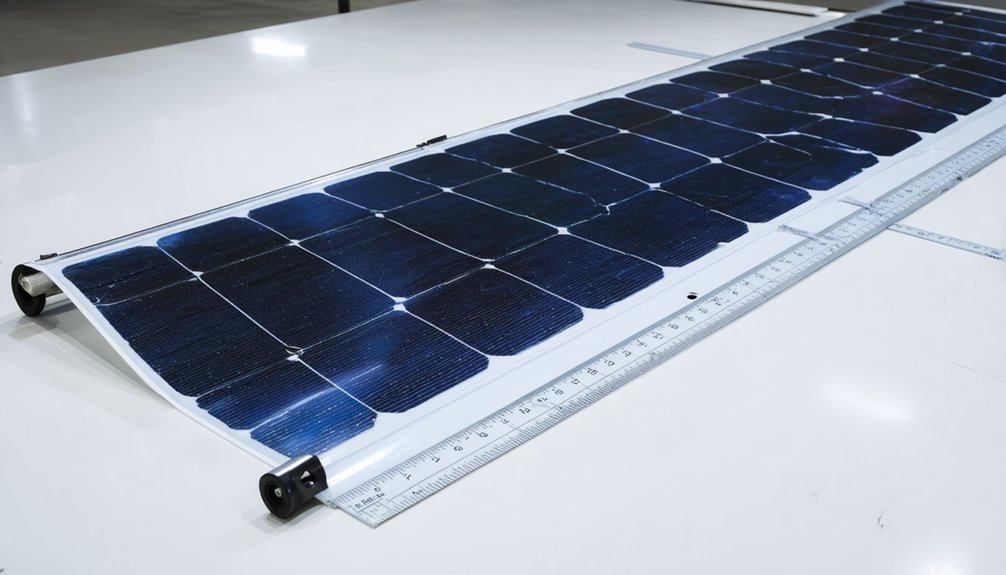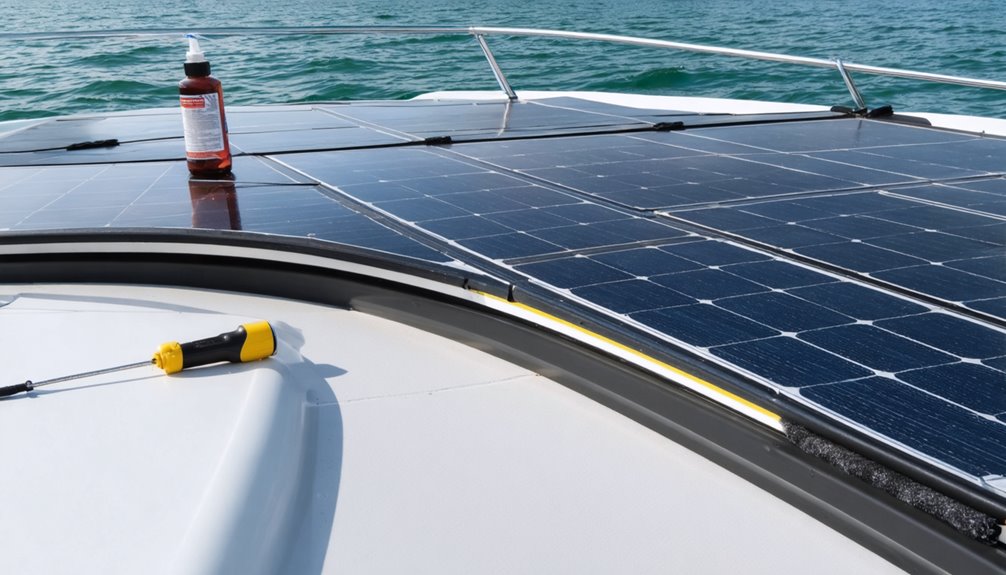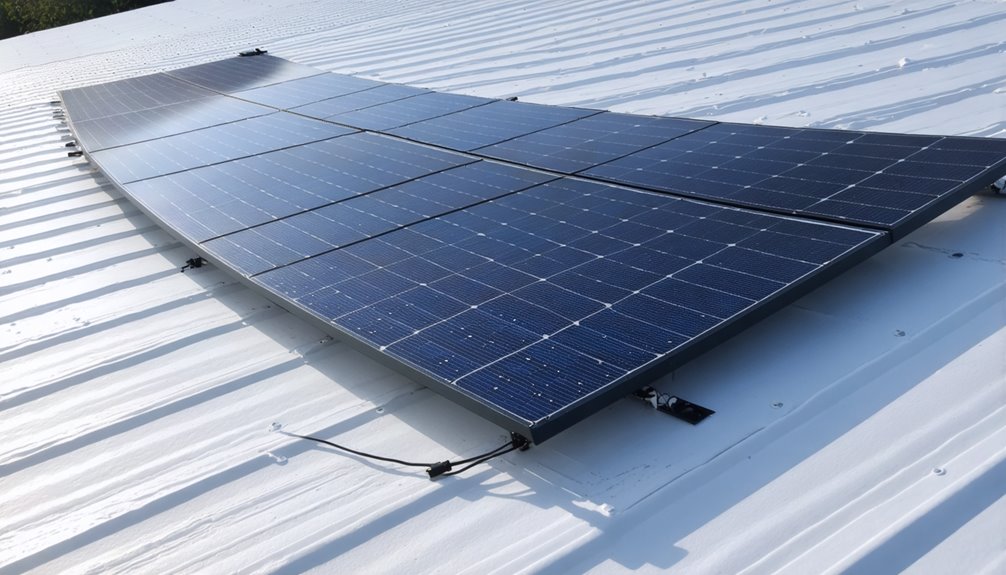To mount a flexible solar panel, guarantee the surface is suitable, such as aluminum or sealed marine plywood. Use adhesives like VHB tape or silicone for secure attachment. Apply adhesive strips every 160mm and allow for curing time while maintaining airflow at the edges. Avoid excess panel flexing to preserve cell integrity. Regular maintenance with neutral soap, water, and denatured alcohol for stubborn residues is essential. There’s more to explore in the nuances of effective solar panel installation.
Protecting the Panels During Installation
To guarantee the proper and safe installation of flexible solar panels, it is vital to prioritize their protection throughout the process. Start by ensuring your solar panels are covered during installation to shield them from potential damage and environmental hazards. Conduct the work in shaded areas or indoors to avoid excessive direct sunlight exposure, which might harm the panels. It is vital to refrain from installing during windy conditions to prevent unwanted movement or damage. Support the panels fully while handling them, as localized stress can cause permanent creases and cell fracturing. Never stack or store items beneath or on top of the panels to maintain their integrity. Following these steps not only aids in protecting the panels during installation but also guarantees long-term performance. Also incorporate proper wind uplift and ballast calculations to ensure safety and code compliance wind uplift.
Safety Precautions to Follow
When installing flexible solar panels, adherence to safety precautions is essential to mitigate risks associated with electrical work and panel handling. Begin by utilizing insulated tools to prevent electrical accidents; this step is significant in any installation involving electricity. It’s also critical to wear personal protective equipment (PPE), including gloves and safety footwear, to safeguard yourself from physical hazards. Always use a sturdy, secure ladder when working at heights to minimize the risk of falls. Additionally, keep the panels covered during installation to shield them from potential damage caused by direct sunlight or adverse weather conditions. If the solar panels are large, don’t hesitate to seek assistance for proper support, ensuring both your safety and the integrity of the panels. Note that most common framed crystalline panels do not come with pre-drilled mounting holes on the back and should not be drilled into; instead use the panel aluminum frame and purpose-built racking hardware to secure modules to roofs or ground mounts.
Understanding Panel Curvature and Flexibility
Having established a foundation in safety precautions, it’s imperative to grasp the intricacies of panel curvature and flexibility for successful flexible solar panel installation. Understanding how much you can bend these panels is essential to preserving panel efficiency. Flexible solar panels can endure a mid-point deflection of up to 100mm over 1.5m without damage but must only bend along one axis, longitudinal or transverse, to avoid stress that could fracture cells. Longitudinal bends should maintain a convex shape and avoid varying radii, while confirming that the bending angle doesn’t exceed 30 degrees per meter is vital for maintaining structural integrity and guaranteeing longevity. Respecting these curvature limits directly influences the panel efficiency and guarantees peak energy conversion throughout the panel’s lifespan.
Proper Handling Techniques for Solar Panels

Master the art of handling flexible solar panels, an essential skill ensuring both safety and ideal performance. Handle these panels with caution, supporting both sides while laying them down to avoid localized stress, preventing cell fracturing. Careful management of flexible solar panels involves adhering to a bending limit of 30 degrees per meter length to safeguard cells and interconnections. Also, carry larger panels vertically along the edge for minimal structural stress. While lifting, slide panels over surfaces to avert creases, which can compromise functionality, ensuring proper support throughout. Only bend them along one axis to protect against excessive curvature, maintaining their integrity.
| Key Technique | Description |
|---|---|
| Support Both Sides | Prevents stress, potential fracturing |
| Carry Vertically | Minimizes structural stress |
| Bend on One Axis | Maintains panel integrity |
Steps for Installation Onto a Rigid Surface
To successfully mount a flexible solar panel onto a rigid surface, you first need to confirm that the surface—such as aluminum, steel, or sealed marine plywood—is suited for the task, considering the effects of thermal expansion to avoid stress or damage to the panel. Use recommended adhesive products like VHB tape or silicone adhesives, maintaining proper airflow by not sealing the edges fully, and apply the VHB tape strips approximately every 160mm while verifying the bonding surface is clean. Allow sufficient curing time for the adhesive, ideally three days, to achieve ideal bonding strength before subjecting the panel to any weight or stress. Additionally, perform general structural checks to confirm the roof can handle the panel’s weight and dynamic loads from wind and snow.
Surface and Adhesive Suitability
Although precise preparation is crucial, understanding the suitability of your surface and adhesive when mounting flexible solar panels onto a rigid surface profoundly impacts the installation’s success. Verify the surface is compatible, using materials like aluminum, steel, or sealed marine plywood, which support ideal adhesion and performance of your solar panels. Cleaning the bonding surface thoroughly to remove contaminants is essential for consistent adhesion. Choose suitable adhesives such as a Vented Gap Kit, VHB tape, or silicone adhesives, while avoiding polyurethanes and MS Polymer adhesives which may reduce effectiveness.
Here’s a quick guide:
| Surface Material | Adhesive Type |
|---|---|
| Aluminum | Vented Gap Kit |
| Steel | VHB Tape |
| Sealed Plywood | Silicone Adhesives |
| Avoid | Polyurethanes, MS Polymer |
This careful selection guarantees a secure and lasting installation on your chosen surface.
Airflow and Thermal Expansion
Understanding the compatibility of your surface and adhesive, as you’ve noted, plays a pivotal role in preparing for the secure installation of flexible solar panels. To accommodate different thermal expansions between the panels and the mounting surface, account for these variations to prevent long-term damage. Ensuring adequate airflow between the solar panel and the rigid surface enhances efficiency and minimizes the risk of overheating, which might damage the panel. Use appropriate adhesives like VHB tape or silicone, avoiding polyurethane and MS Polymer adhesives due to poor bonding characteristics. Maintain a smooth, well-drained surface, resolving any droops beforehand, to reduce stress and moisture accumulation. Protecting against potential water pooling is essential, as moisture can degrade panel performance and longevity.
Best Adhesives and Methods for Mounting
When mounting flexible solar panels, selecting the appropriate adhesive and technique is vital to ensuring durability and efficiency, given that silicone-based adhesives are particularly suitable because they accommodate panel flexibility; these adhesives should be carefully applied beneath each cell gap without sealing the edges, mitigating the risk of trapped air that might otherwise compromise the panel’s integrity. Additionally, bi-adhesive backing offers a convenient peel-and-stick option, ideal if you’re installing panels in areas where they may be walked on. It’s essential to prevent over-flexing during installation. High bond tape is another practical choice, provided the bonding surface is clean, and compatibility is confirmed, though it’s significant to mention that not all tapes are effective for textured surfaces. Use aluminum composite only for such conditions.
Effective Mounting on Textured Surfaces
Mounting flexible solar panels on textured surfaces involves careful consideration of materials and techniques to guarantee a secure and effective installation. For reliable solar panel mounting, utilize aluminum composite materials, as textured surfaces can make high bond tape ineffective. Securely attach the aluminum to checker plate surfaces, using screws or appropriate adhesives, confirming a stable base. Before mounting, address any surface droops; creating a well-drained bonding area prevents water from pooling beneath the panels. Follow standard mounting procedures to attach the panels to the aluminum, assuring a robust and supportive connection. Additionally, maintain a clean and adequately prepared bonding surface to enhance adhesion, which is vital for the performance and longevity of the solar panel installation. Proper adherence assures peak energy generation.
Maintenance Tips for Long-Lasting Performance

To sustain your flexible solar panel system‘s best performance over time, diligent maintenance becomes indispensable. You should regularly clean your panels using a neutral soap and water solution to remove dirt and grime that can diminish performance and efficiency. For those in marine environments, frequently rinse your panels with fresh water to prevent corrosive salt buildup. Periodic inspections of mechanical and electrical connections are essential to guarantee that all components provide a secure interface and function correctly, maintaining maximal efficiency. Use denatured alcohol to remove stubborn grease and residues without harming the panel surface. Maintain a detailed maintenance checklist, including cleaning schedules and inspection intervals, to systematically monitor and uphold the longevity and efficiency of your solar panels effectively.
Examples of Good and Bad Installations
Although installation practices might vary, understanding the characteristics of good and bad installations is essential for optimizing the performance of your flexible solar panels. When panels are installed with a supportive canvas backing across the entire surface, stress on the cells is minimized, greatly enhancing durability. Panels are ideally mounted with a slight bend in one axis, distributing sun strength evenly without risking excessive flexing. Cables should be neatly organized, preventing forces that could endanger the junction box’s integrity. Conversely, bad installations are evidenced by creased panels that increase cell stress, impacting functionality and leading to potential hot spots. Panels that flex in multiple directions lack proper support, risking stress-induced fracturing, which underscores the critical importance of precise alignment.
Conclusion
When mounting flexible solar panels, guarantee protective measures during installation to prevent damage, comply with safety standards, and understand the flexibility limits and curvature to maintain panel integrity. Employ proper handling techniques and apply appropriate adhesives for secure attachment to both rigid and textured surfaces. Adherence to these guidelines will optimize performance and longevity, minimizing risks of malfunction. Maintenance should focus on regular inspections and cleaning to sustain efficiency, while examining installation examples offers insight into effective practices.
Successful installation of flexible solar panels requires careful attention to protective measures, proper handling techniques, and appropriate mounting methods to ensure optimal performance and durability. Regular maintenance through inspections and cleaning further supports long-term efficiency and system reliability. Solocity Global serves as a trusted exporter of solar panel mounting systems, providing comprehensive solutions that meet international quality standards. The company supplies high-quality mounting hardware and components to clients worldwide, supporting diverse solar installation requirements across multiple markets.


